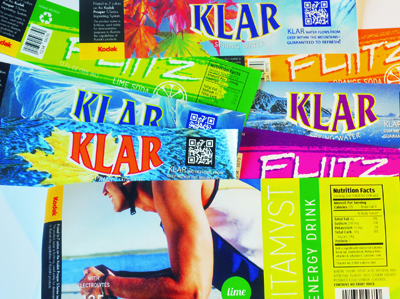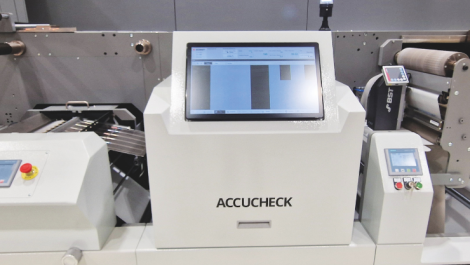Kodak inkjet-printed Jindal Films 30 micron BOPP wraparound labels
In all printing the interaction between ink and substrate determines the final result; in digital printing these interactions, along with the drying mechanism, is critical. By Sean Smyth.
As digital print methods account for just a small proportion of packaging volumes, most materials are designed to perform well with litho or flexo print methods, but this is changing for label substrates where digital has made larger strides.
The particular surface properties of a substrate are different for the various digital print processes used in packaging, whether dry or liquid toner, water-based or UV curing inkjet. For instance, a substrate for a powder toner system has to stand up to heat and pressure, meaning heat-sensitive materials may not be applicable, while in inkjet the surface has to allow the wet ink to spread to the correct degree to optimise print quality, still delivering good adhesion and durability.
There may be a surface treatment required. In some cases this could be a separate priming stage to optimise the surface. Increasingly it will be incorporated at manufacturing as the volume of digital packaging and labels grows.
Suitability
It is important to use a material that is suited to the particular process. Many of the machine suppliers will provide a list of certified materials that perform well, for example the Rochester Institute of Technology provides a database of certified HP Indigo stocks. A customer can select the region, press model used and substrate category, and the system delivers the approved materials for that location, detailing manufacturer and supplier. Conversely, some of the main substrate suppliers provide lists of their materials that will perform on a particular press. Avery Dennison provides lists of label stocks for a press manufacturer with the portfolio of products suitable for HP Indigo, Xeikon, Colordyne, Epson, Primera, Domino, Durst, EFI Jetrion and Mark Andy machines available to view and download from its website.
Avery Dennison stresses the benefit of matching the right media to the print technology used. Its experience shows that converters sometimes buy presses assuming that standard flexo or litho substrates are printable, which is not always the case. The company has invested in digital media solutions, providing special top-coated material that create a chemical bond between the ink and substrate surface when HP Indigo presses are used without the need for priming on press.
Xeikon dry toners adhere to most label stocks without any additional surface modification or coating. Optimised papers and films are available for UV inkjet printers and water-based inkjet technology. Avery Dennison now offers a comprehensive portfolio for inkjet presses, designed to balance ink adhesion with line and image quality. The products have been validated and approved by the press manufacturers involved.
Application specific
There are new materials designed for specific digital print applications coming onto the market.
One example in 2018 is UPM Raflatac introducing its Synlite Xtra outdoor-resistant film face material to the European market. This material is suitable for industrial chemical labelling applications that require a high level of resistance to challenging outdoor conditions. Showing good printability, this is a lightweight and production-efficient PP-based matt film that offers good UV resistance.
The film is paired with the company’s high-tack RC77 adhesive, which also offers good UV resistance as well as good adhesion on polar and non-polar surfaces. RC77 performs well in even the most demanding outdoor environments, ensuring that labels displaying critical information about container contents and any safety requirements remain firmly in place for the life of the container. The combination also complies with the requirements of the BS 5609 standard for seawater resistance to ensure that dangerous goods transported by sea are durably labelled and identified.

Sappi Fusion Uncoated containerboard
‘We are very pleased to be able to add this new film to our ever-expanding range of solutions for highly demanding applications. Synlite Xtra with RC77 answers our customers’ needs for a durable, reliable, and standards-compliant solution for industrial chemical labelling,’ explained Jouni Iiskola, segment manager, oil and industrial chemical, special business, EMEIA.
Jindal Films is a leading supplier of films for labels and flexible packaging and it sees digital printing as an important sector. It acquired ExxonMobil Chemical Films in 2013 and has an annual capacity of 445k tonnes of BOPP film and 125k tonnes of PET film. It engineers the surface characteristics of the film to work with the inks (and adhesives) used in the conversion process.
As interest in digital printing has grown it has developed a range of products. Terry Jensen, North American marketing and printing manager, commented, ‘Today our customers are frequently asking about inkjet technology and the availability of press ready films. Jindal is developing a range of suitable films to take advantage of the rapidly growing market. We have worked closely with Kodak to develop suitable flexible packaging grades that give excellent performance using the high-speed Prosper inkjet system.’ Press ready films for water-based inkjet are on the rise. Kodak showed very high quality wrap-around labels on Jindal’s Label-Lyte 38DL247 30 micron OPP film, which was primed and printed with water-based inkjet inks at speeds up to 200m/min on a modified Uteco flexo press.
This approach involves a separate priming operation, coating and drying a water-based primer to provide the required surface properties for good printability and adhesion. HP Indigo label and packaging presses come with a priming unit, a simple flexo flood coater that boosts adhesion of the ElectroInk onto paper or filmic stocks. Many Indigo materials (and HP has certified thousands of potential packaging substrates) are supplied as top-coated.
HP water-based inkjet presses feature a pre-print bonding agent; a separate inkjet bar where the colourless bonding agent is printed onto areas of the paper that will be printed with black and colour inks only where the paper receives ink. This immobilises the ink pigments near the paper surface to control the spread and penetration of the ink, improving colour saturation and black optical density on standard offset papers.
Saving weight
Sappi has developed Fusion Uncoated as a top liner for corrugated where the low weights (70-130gsm) are helping to meet the rising demand for weight savings with corrugated board packaging while the grade offers excellent printability with digital.
Fusion Uncoated is approved for direct food contact and is recommended for use when branded product manufacturers, designers and corrugated board processors are seeking an alternative to brown liner papers. These applications include inner packaging such as white corrugated board inserts for high-end perfume boxes as well as food packaging.
Also in corrugated, Mondi is looking at ways of improving the print quality of paper used as corrugated liner as inkjet use grows, as well as carton boards. It is adding surface treatments to improve the ink fixation to get better end density and colour gamut on uncoated and coated grades.
As inkjet print grows, both with UV and water-based inks, more paper makers are looking at improving the achievable print quality. For water-based inks there are surface treatments and priming that cause the colourant to separate from the water and remain at the paper surface. An easy way is to use a salt (sodium chloride) solution that agglomerates the pigment particles together with binder on contact, meaning there is no chance of the pigment being absorbed into the body of the paper with the water, which further helps the drying speed.
There is a significant market for inkjet papers and this will grow in cartons, corrugated and flexibles, both paper and films. Alkyl ketene dimer (AKD) is the most common neutral/alkaline sizing agent used. The Finnish Research Institute VTT is examining novel materials including nano-fibrillated cellulose (NFC). Its research shows that adding hydrophilic NFC to the AKD sizing helps to fix the pigment at the surface, resulting in higher end density and less strike effects. There are other approaches as paper manufacturers compete to deliver optimal inkjet substrates.
Converters will look to use the same materials on digital presses that they use on analogue presses, often baulking at the premiums charged by suppliers. Some work well, others not so and the onus is on the converter to check the performance across the supply chain, not just on the press. More materials are being developed for digital print, and with increasing volumes competitive pressures will reduce the premiums for digital versions. In the short term priming may be necessary to get a good result, but there will be more press-ready materials coming onto the market.






